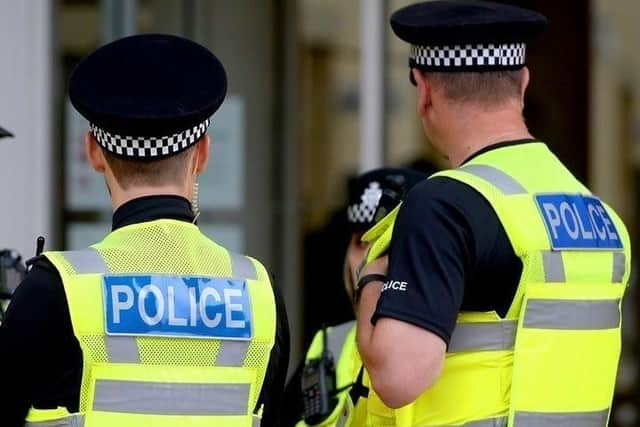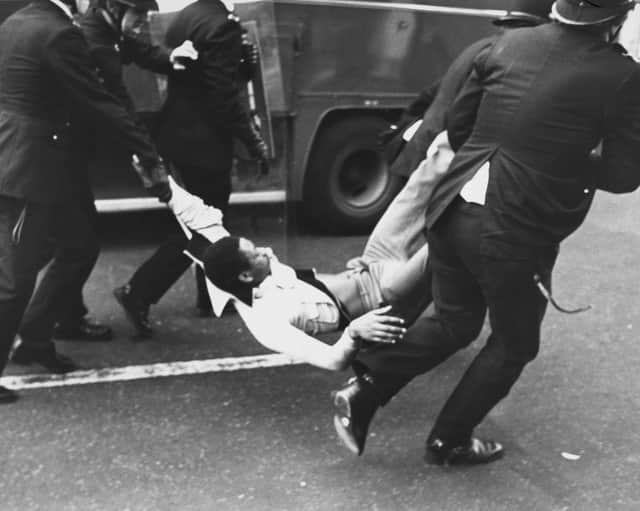South Yorkshire Police: Black people twice as likely to be stop and searched
and live on Freeview channel 276
A Star investigation into South Yorkshire Police (SYP) data has shown people determined to be either black, asian or another ethnic minority by police officers are all more likely to be targeted in a stop and search check than those determined to be white.
Using police data, The Star aggregated the likelihood of being stop and searched for each ethnic group per 100,000 people.
Advertisement
Hide AdAdvertisement
Hide AdIn South Yorkshire, there were be 918 stop and searches per 100,000 black people, compared to 465 per 100,000 asian people; 227 per 100,000 white people; and 236 per 100,000 people categorised by South Yorkshire Police as "other". Overall, there were 534 stop and searches per 100,000 people of a non-white ethnic background.
According to the 2021 Census, just over 12 per cent of South Yorkshire's population have either black, asian or "other" ethnic backgrounds, yet 21 per cent of South Yorkshire Police's stop and searches are carried out on people from these backgrounds.
2.5 per cent of the region's population are black, but nine per cent of SYP's stop and searches are of black people.
10.5 per cent of stop and searches are carried out on asian people, who make up 5.7 per cent of the population.
Advertisement
Hide AdAdvertisement
Hide Ad79.5 per cent of SYP stop and searches on black people result in "no further action", exceeding the regional average of 69.8 per cent and the 68 per cent of stop and searches white people are subject to.
Analysis shows stop and search numbers do not correlate to 'high crime areas'
In response to The Star's findings, Chief Inspector Gareth Thomas, SYP's stop and search lead, said: "Stop and search is a crucial policing tactic that enables us to protect and serve the public of South Yorkshire, by preventing and reducing violent crime, and removing drugs and weapons from our streets.
“We review stop and search statistics to understand the reasons behind any disproportionality in the members of the community that we search. We take an evidence-based approach and review studies and research to understand why members of certain communities are more frequently the subject of stop and search."
Chf Insp Thomas also said disproportionality is a "national issue", adding: "Some studies suggest that disproportionality is affected by interaction with communities who reside in areas with higher volumes of crime, which in turn may lead to the stop and search figures being disproportionate."
Advertisement
Hide AdAdvertisement
Hide Ad

Further analysis following Chf Insp Thomas' comments revealed it is not as simple as "some studies" suggest.
From January to April 2023, crime map data in Sheffield specifically, shows more incidents relating to violence and sexual offences, drugs and possession of weapons were recorded in Sheffield South East (2,386) than Sheffield North East (2,278).
Crime maps, collated by police.uk, plot the locations of reported crimes on a map of Sheffield, including those referenced by Chf Insp Thomas - violence and sexual offences, drugs and possession of weapons.
Burngreave, Pitsmoor and Fir Vale, which fall under the jurisdiction of the Sheffield North East policing team, have the highest proportions of black and asian people in Sheffield, according to the 2021 Census.
Advertisement
Hide AdAdvertisement
Hide AdComparatively, the Sheffield South East policing team features a number of communities where populations are in excess of 90 per cent white, including Birley, Gleadless and Stradbroke.
When contacted again by The Star, South Yorkshire Police clarified the studies' findings are not a "definitive conclusion" for disproportionality in stop and search.
The force also said the crime map data can be "skewed" due to when the figures are extracted from the SYP website, but did acknowledge The Star's analysis shows "how complex and multi-faceted this issue is" and "it’s imperative that work continues to understand disproportionality".
The history of stop and search
Stop-watch.org is an organisation monitoring the use of stop and search powers in the UK. According to their website, stop and search was first introduced to police powers in 1824, allowing police to stop and search anyone they deemed "suspicious".
Advertisement
Hide AdAdvertisement
Hide AdThese laws were still in place over 150 years later, when Operation Swamp 81 - a police crackdown on street crime in Brixton, London - was launched. This operation mostly targeted young black men, with police making over 1,000 stops in Brixton in just six days - which Stop Watch said led directly to the 1981 Brixton Riots.


In modern Britain, the Conservative Government are aiming to expand stop and search powers in what Stop Watch have said is an "attempt to crack down" on protestors and activists.
After the Casey Report into the Metropolitan Police in March this year, Tory MP David Davis said Theresa May's "curtailment" of stop and search powers in 2010 was because ethnic minority communities felt the tactic was "targeted on them" and "it actually made race relations in the capital worse".
Baroness Casey found the Met's use of stop and search was reducing the force's legitimacy.
